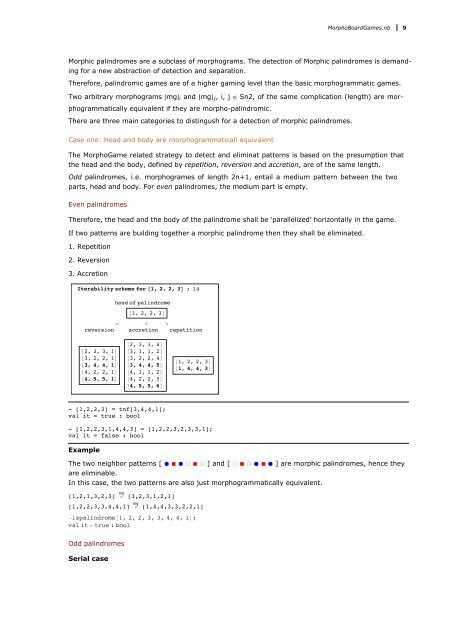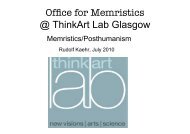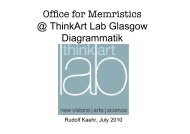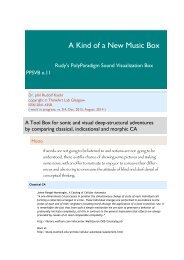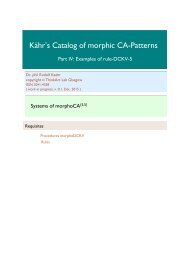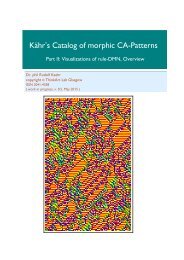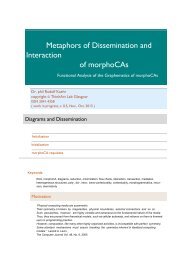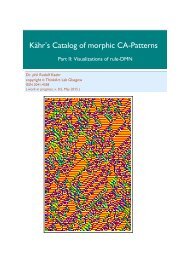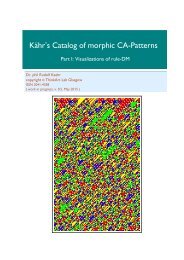Towards a new Paradigm of Board Games
"There is no reason that forces the game industry to restrict itself on a paradigm of games that is repetitive, addictive, regressive and is denying the right of the user to develop his/hers intellectual capabilities of creativity. It is a strategic decision of the game industry to stupidify its costumers." ThinkArt Lab To introduce the paradigm of morphic (board) games, I start with two simple questions. Why are classical games producing regressive addiction and boredom? What are the differences between classical and morphic games? My first answers to the questions might be summarized as follows: Classical games are based on the perceptive acts of identification and separation of the elements of the game by the rules of the game. Morphic Games are involved into differentiations and structurations of interactive and reflectional patterns (morphograms) in complex constellations. For a more conceptual answer of the two questions I connect the proposed new kind of games to the theory and practice of morphogrammatics. What do I understand by morphogrammatics? Morphogrammaitics is a pre-semiotic theory of inscription. It is studying and formalizing the 'deep-structure' of semiotics. Mathematically, morphograms, as the fundamential patterns of morphogrammatics, are representations of Stirling numbers of the second kind. Formal semiotics consists of an sign repertoire and rules of maipulating its signs. This is established by a strict difference of operators and oprands (signs). In contrast, morphograms are playing a double role: they are involved in a chiastic interplay of patterns (operands) and rules (operators). This is in decisive conterast to identity-based semiotic systems that are based on atomic signs. Strings of signs are based on a set of signs with cardinality m and its potentiation (n): m^n. Hence for m=4 and n=4, there are exactly 4^4 = 256 different semiotic strings possible. But on a morphogrammatical level there are just exactly Sn(4,4) = 1+6+7+1=15 morphograms for m=n=4 possible. In this sense, those 15 morphograms are presenting the 'deep-structure' of the set of semiotic strings of length 4.
"There is no reason that forces the game industry to restrict itself on a paradigm of games that is repetitive, addictive, regressive and is denying the right of the user to develop his/hers intellectual capabilities of creativity.
It is a strategic decision of the game industry to stupidify its costumers." ThinkArt Lab
To introduce the paradigm of morphic (board) games, I start with two simple questions.
Why are classical games producing regressive addiction and boredom?
What are the differences between classical and morphic games?
My first answers to the questions might be summarized as follows:
Classical games are based on the perceptive acts of identification and separation of the elements of the game by the rules of the game.
Morphic Games are involved into differentiations and structurations of interactive and reflectional patterns (morphograms) in complex constellations.
For a more conceptual answer of the two questions I connect the proposed new kind of games to the theory and practice of morphogrammatics.
What do I understand by morphogrammatics?
Morphogrammaitics is a pre-semiotic theory of inscription. It is studying and formalizing the 'deep-structure' of semiotics.
Mathematically, morphograms, as the fundamential patterns of morphogrammatics, are representations of Stirling numbers of the second kind.
Formal semiotics consists of an sign repertoire and rules of maipulating its signs. This is established by a strict difference of operators and oprands (signs).
In contrast, morphograms are playing a double role: they are involved in a chiastic interplay of patterns (operands) and rules (operators).
This is in decisive conterast to identity-based semiotic systems that are based on atomic signs. Strings of signs are based on a set of signs with cardinality m and its potentiation (n): m^n. Hence for m=4 and n=4, there are exactly 4^4 = 256 different semiotic strings possible.
But on a morphogrammatical level there are just exactly Sn(4,4) = 1+6+7+1=15 morphograms for m=n=4 possible. In this sense, those 15 morphograms are presenting the 'deep-structure' of the set of semiotic strings of length 4.
You also want an ePaper? Increase the reach of your titles
YUMPU automatically turns print PDFs into web optimized ePapers that Google loves.
Morpho<strong>Board</strong><strong>Games</strong>.nb 9<br />
Morphic palindromes are a subclass <strong>of</strong> morphograms. The detection <strong>of</strong> Morphic palindromes is demanding<br />
for a <strong>new</strong> abstraction <strong>of</strong> detection and separation.<br />
Therefore, palindromic games are <strong>of</strong> a higher gaming level than the basic morphogrammatic games.<br />
Two arbitrary morphograms @mgD i and @mgD j , i, j œ Sn2, <strong>of</strong> the same complication (length) are morphogrammatically<br />
equivalent if they are morpho-palindromic.<br />
There are three main categories to distingush for a detection <strong>of</strong> morphic palindromes.<br />
Case one: Head and body are morphogrammaticall equivalent<br />
The MorphoGame related strategy to detect and eliminat patterns is based on the presumption that<br />
the head and the body, defined by repetition, reversion and accretion, are <strong>of</strong> the same length.<br />
Odd palindromes, i.e. morphogrames <strong>of</strong> length 2n+1, entail a medium pattern between the two<br />
parts, head and body. For even palindromes, the medium part is empty.<br />
Even palindromes<br />
Therefore, the head and the body <strong>of</strong> the palindrome shall be ‘parallelized’ horizontally in the game.<br />
If two patterns are building together a morphic palindrome then they shall be eliminated.<br />
1. Repetition<br />
2. Reversion<br />
3. Accretion<br />
Iterability scheme for @1, 2, 2, 3D ; 14<br />
head <strong>of</strong> palindrome<br />
@1, 2, 2, 3D<br />
á ¯ ä<br />
reversion accretion repetition<br />
@2, 3, 3, 1D<br />
@3, 2, 2, 1D<br />
@3, 4, 4, 1D<br />
@4, 2, 2, 1D<br />
@4, 5, 5, 1D<br />
@2, 3, 3, 4D<br />
@3, 1, 1, 2D<br />
@3, 2, 2, 4D<br />
@3, 4, 4, 5D<br />
@4, 1, 1, 2D<br />
@4, 2, 2, 5D<br />
@4, 5, 5, 6D<br />
@1, 2, 2, 3D<br />
@1, 4, 4, 3D<br />
- [1,2,2,3] = tnf[3,4,4,1];<br />
val it = true : bool<br />
- [1,2,2,3,1,4,4,3] = [1,2,2,3,2,3,3,1];<br />
val it = false : bool<br />
Example<br />
The two neighbor patterns [ Ê ‡ Ê Á ‡ Á ] and [ Á ‡ Á Ê ‡ Ê ] are morphic palindromes, hence they<br />
are eliminable.<br />
In this case, the two patterns are also just morphogrammatically equivalent.<br />
[1,2,1,3,2,3] = mg [3,2,3,1,2,1]<br />
[1,2,2,3,3,4,4,1] = mg [1,4,4,3,3,2,2,1]<br />
-ispalindrome@1, 2, 2, 3, 3, 4, 4, 1D;<br />
val it = true : bool<br />
Odd palindromes<br />
Serial case


